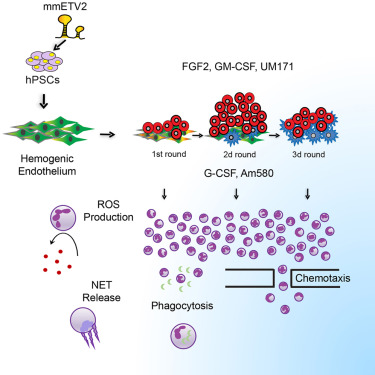Stem Cell Reports ( IF 5.9 ) Pub Date : 2019-11-07 , DOI: 10.1016/j.stemcr.2019.10.007 Vera S Brok-Volchanskaya 1 , David A Bennin 2 , Kran Suknuntha 3 , Lucas C Klemm 2 , Anna Huttenlocher 2 , Igor Slukvin 4

|
Human induced pluripotent stem cells (hiPSCs) can serve as a versatile and scalable source of neutrophils for biomedical research and transfusion therapies. Here we describe a rapid efficient serum- and xenogen-free protocol for neutrophil generation, which is based on direct hematoendothelial programming of hiPSCs using ETV2-modified mRNA. Culture of ETV2-induced hematoendothelial progenitors in the presence of GM-CSF, FGF2, and UM171 led to continuous production of generous amounts of CD34+CD33+ myeloid progenitors which could be harvested every 8–10 days for up to 30 days of culture. Subsequently, myeloid progenitors were differentiated into neutrophils in the presence of G-CSF and the retinoic acid agonist Am580. Neutrophils obtained in these conditions displayed a typical somatic neutrophil morphology, produced reactive oxygen species, formed neutrophil extracellular traps and possessed phagocytic and chemotactic activities. Overall, this technology offers an opportunity to generate a significant number of neutrophils as soon as 14 days after initiation of differentiation.
中文翻译:

使用 ETV2 修饰的 mRNA 从诱导的多能干细胞中有效和快速地生成功能性中性粒细胞。
人类诱导多能干细胞 (hiPSC) 可作为用于生物医学研究和输血疗法的多功能且可扩展的中性粒细胞来源。在这里,我们描述了一种用于中性粒细胞生成的快速有效的无血清和无异种原方案,该方案基于使用 ETV2 修饰的 mRNA 对 hiPSC 的直接血内皮编程。在 GM-CSF、FGF2 和 UM171 存在下培养 ETV2 诱导的造血内皮祖细胞导致连续产生大量 CD34 + CD33 +骨髓祖细胞可每 8-10 天收获一次,最多可培养 30 天。随后,在 G-CSF 和视黄酸激动剂 Am580 存在下,骨髓祖细胞分化为中性粒细胞。在这些条件下获得的中性粒细胞表现出典型的体细胞中性粒细胞形态,产生活性氧,形成中性粒细胞胞外陷阱并具有吞噬和趋化活性。总体而言,这项技术提供了在分化开始后 14 天产生大量嗜中性粒细胞的机会。











































 京公网安备 11010802027423号
京公网安备 11010802027423号